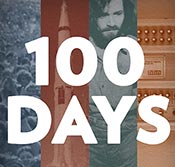Highlights
100 Days: How Four Events in 1969 Shaped America
_________________________
I
Moon
July 16–24, 1969: Astronauts land on the moon
“As a single undertaking, Apollo 11 was the most complex and technically demanding venture ever attempted, engaging the labors of more than 400,000 Americans—contractors, planners, engineers, scientists, technicians, vendors—from every state in the nation. The program that had produced a mission to the moon was also the largest peacetime expense in U.S. history—an outlay so vast in a troubled age that even the president who had proposed it would privately express doubts about its value.”
_____
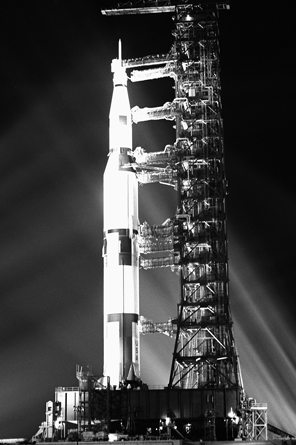
The Saturn V rocket with Apollo 11 spacecraft, ready for its July 1969 journey to land American astronauts on the moon.
“The scientific groundwork that had led to Apollo could be recounted as a study in contrasts—the product of noble vision and political brinkmanship, of crushing deadlines and masterly successes, of great personal achievement and broken careers. And Apollo had exacted a dreadful price almost before the program began, when three astronauts, trapped in a spacecraft they knew was flawed, would die.”
_____
“For Wernher von Braun, technical director of the German army’s rocket center, his surrender marked the end of creating weapons for the Nazis and the start of work with his former enemies. It was also the beginning of one of the most morally disturbing episodes of the war and its aftermath—illuminating as much about those who created the V-2 and the crimes against humanity used to produce those weapons as it said about America’s decisions concerning national security in a postwar world.”
_____
“What would eventually prod the United States into a massive effort in space was an event that should have been expected but was a complete surprise to most: when it came, it arrived in the form of a solitary beeping sound and a tiny flash of light across the sky…”
_____
“But before final plans could be formulated, any part of the government—military or civilian—needed to get an American satellite into orbit. The navy group assured the president that it would be ready for launch. Eisenhower announced that Vanguard would launch in December 1957.
“It was a national disaster…”
_____
“When John Kennedy was elected president in 1960, a new approach would be needed to engage the young president in the excitement of space. But even then, and long after he had committed the nation to the most daunting peacetime goal in the nation’s history, Kennedy would still be left with concerns about the importance of the effort.”
_____
“NASA was ready to proceed with the Apollo program, which was set to begin in February 1967 with a Saturn 1-B rocket to test the spacecraft and its service module in Earth orbit.
“But in January, luck ran out…”
_____
“Two men walked on the moon, and the world stopped. On small televisions at markets in India, on a giant screen for 150,000 in a park in Seoul, on radios in Norway as Laplanders herded reindeer under the nighttime arctic sun, in Australian courtrooms during recess, and at military bases in Vietnam—the world came together for two men on the moon.
“For a moment,” recalled one reporter, “earthly concerns fell away.”
__________________________________________________
Counterculture
One Week of the Darkest and the Brightest
“The real impact of young people in America was just beginning to be heard, not only through the success of young Americans in the mainstream of life in the United States but also with even stronger voices in the counterculture that was developing across the country.”
_____
“The counterculture of the 1960s would continue to evolve into the early 1970s, but in 1969, two events in particular—only a week apart—would symbolize both the worst and the best of the era: the first demonstrated the tragic vulnerability of some who sought alternatives to mainstream America, and the second showcased the new generation at its best…”
__________________________________________________
II
Manson
August 8–10, 1969: The Manson “Family” kills seven in Los Angeles
“Any summer morning in August, Sunset Boulevard is busy in both directions, but two police cars had no trouble making their way east to Benedict Canyon Drive, where they headed north toward the hills. The patrol cars from the Los Angeles Police Department were responding to calls from residents who were trying to soothe a local housekeeper who had been screaming about discovering bodies and blood when she arrived for work at 10050 Cielo Drive. The first two officers on the scene questioned the housekeeper at a neighbor’s house where she had run, then they went up to 10050.
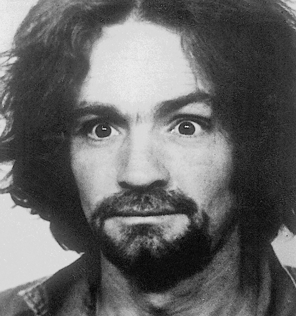
This photo of a “crazed” Charles Manson — actually a mug shot taken the year before the murders — became one of the iconic images of the 1960s.
“They found a nightmare.”
_____
“For weeks, the murder of seven on two nights in Los Angeles defied reason or explanation. And months later, when it became clear that the murders were the responsibility of a crazed career criminal leading a band of young drugged-out social rejects, the story seemed to confirm the worst fears of mainstream America about the evils of 1960s counterculture.
“But when the full story became clear of how Charles Manson created a distorted vision of race war, it would change forever how America viewed crime and murder.”
_____
“…As lonely, disillusioned teenagers, Leslie Van Houten and Suzanne Cosgrove didn’t know each other, but the patterns of their early lives were so closely matched that they could have been sisters. Van Houten and Cosgrove are less than a year apart in age, and as children they lived in some of the same neighborhoods. In their youth they experienced many of the same tragedies and traumas, and both would spend time within a prison—although for vastly different reasons.
“But the stories of Van Houten and Cosgrove explain much about how some lives were shaped in the 1960s and how far wrong they could go; one of them would become a killer while the other persevered…”
_____
“Manson may have played the ultimate cosmic joke on the world: the more we try to figure him out, the less we really understand him. However, when we see the real Manson, not as a larger-than-life philosopher about violence in America, and not as a guilt-inspiring reflection of each of us, but instead by pulling back the curtain and exposing the pure sociopath within, then the understanding of him becomes clear…”
__________________________________________________
III
Woodstock
August 15–18, 1969: Woodstock brings together 400,000
for “three days of peace and music”
“The Woodstock concert in the Catskills of rural New York on the August 15 weekend presented the paragons of 1960s rock music, from Jimi Hendrix to Jefferson Airplane to the Grateful Dead—in all, 32 acts playing day and night until Monday morning. But it was clear from the start that Woodstock would become much more than a concert: it was a weekend that would become a social and cultural milestone in the American experience.”
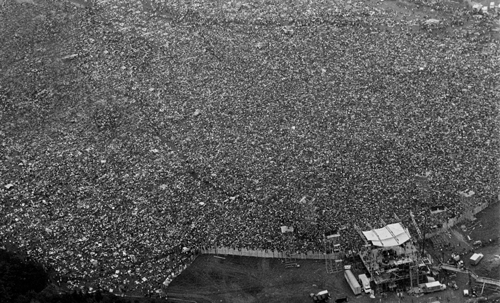
The Woodstock concert at its peak attendance on Saturday, August 16 — more than 400,000 who would be the first in the “Woodstock Generation.”
_____
“The clash of values that surrounded planning the event almost sank the whole project, but by the time the concert weekend occurred—and in spite of crowds beyond any expectations, intolerable weather, a lack of food and water, and emergency resources strained to their limits, Woodstock was a symbol of how a whole community can become the best of what people are and what they hope to be. The 400,000 who attended would arrive enthusiastic and dry; they left muddy, hungry, and soaked—and part of the Woodstock generation.”
_____
“There are many voices of Woodstock, and in spite of “hippiefest” characterizations reported by newspapers across the country, most who attended did not fit that description. Many protested the war and attended marches for peace or civil rights, but they were not societal dropouts. They did not live on communes. They were not profound philosophers of their era. And other than smoking the occasional joint, most of them did not abuse drugs. The vast majority of the 400,000 at Woodstock were just young people challenged by a challenging age as they struggled to find direction in their lives. For many, they would find the beginnings of their focus at Woodstock…”
_____
“Among those who witnessed the transformation of the crowd was Mike Kaufman, a reporter who had walked six miles to reach the festival. As he experienced Woodstock over the next two days, Kaufman, who had covered everything from wars to the Dalai Lama, was awed by the spectators and the well-being that prevailed.
“I was completely overwhelmed,” Kaufman recalled 40 years later. Comparing the weekend to the only other event in his life with the same impact—Martin Luther King Jr.’s march on Washington in 1963—Kaufman realized that at Woodstock, “I was watching consciousness change in an afternoon.”
__________________________________________________
IV
Internet
October 29, 1969: An experiment at UCLA and Stanford
Research Institute signals the birth of the Internet
“…During the day, Boelter Hall on the UCLA campus teems with engineering students. But in the evening, with most student housing far across the campus, the building descends into quiet solitude—an ideal setting for work that requires time and focus.
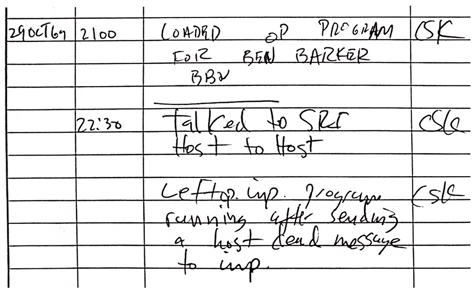
On October 29, 1969, at 22:30 (10:30 p.m.), UCLA graduate student Charley Kline recorded a connection between the computer in the university’s Network Measurement Laboratory and a computer staffed by Bill Duvall at the Stanford Research Institute. As much as any moment would be, this was the first cry of the newborn Internet.
It was a perfect night to change the world…”
_____
“…From a modest beginning, the Internet would become the most pervasive communications tool of its age—possibly of any age—affecting everything we do, say, and achieve. It serves as an instrument for soaring to creative heights, and it spotlights troubling questions about the lowest forms of human depravity. It produces unprecedented opportunities for social interaction while raising deep questions about personal privacy and national security. Because of the Internet, perhaps more than any other technology, the world is now a much different place, and the world continues to be reshaped as the Internet changes.
“…But as a starting point of this journey, it could also be said without too much overstatement that the Internet was born out of frustration and one man’s need to find more space on his desk…”
_____
“The business of creating online organizations was brisk; from the mid-1990s until 2000, investing in budding dot-coms was the wildest of rides, expanding with an aura of wealth, power, and optimism that had become the hallmarks of the go-go Internet world.
“But behind lucrative deals festered a problem—a simple, disaster-provoking problem: for the most part, neither the new dot-com companies nor the investors who bought into them had the slightest idea what they were doing.
“The dot-com bubble,” said Jeffrey Cole, director of the Center for the Digital Future, “was business plans written on the backs of napkins.”
_____
“As a cautionary tale and a business school lesson about irrational investor expectations, no modern example proved better than the dot-com bubble. But beyond the hysteria came a message that was even more telling…”
_____
“Something innovative was emerging that would have significant benefits for users. While the dot-com bust was raging out of control, a new technology had evolved that so profoundly changed the experience of going online at home that it would become almost as influential as the creation of the Internet itself…”
_____
“Three issues in particular would speak loudest about how Jeff Bezos and Amazon have shifted e-commerce and its effects on the American experience: every mistake Bezos did not make while most of his competition was drowning, his near-obsession about dealing with his customers, and how one product in particular would fundamentally change how millions of Americans shop and perceive the role of e-commerce in their lives…”
_____
“There is a story about the Internet that vividly illustrates how swiftly events can change in the online world: two historians decided to write a book about the future of the Internet. A publisher told them, “If you can make a case for major changes to come in the Internet, I’ll buy your idea.”
“But the historians could see nothing on the near horizon that seemed like a major transformation to come, so they gave up their idea for a book, thinking that the Internet, as far as they could see, would thrive without major changes for the foreseeable future.
In the next five years came Facebook (2004), YouTube (2005), Twitter (2006), the iPhone (2007), and the Android operating system (2008)—five developments among many that would, yet again, profoundly reshape the Internet in the American experience…”
_____
